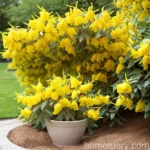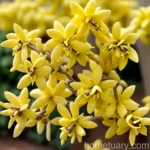Winter Jasmine (Jasminum nudiflorum): A Complete Guide
Introduction
Winter jasmine (Jasminum nudiflorum) is a delightful and ornamental woody shrub that belongs to the olive family, Oleaceae. This plant is native to China and is appreciated for its ability to bloom during the winter months. Its delicate yellow flowers add an appealing touch of color to an otherwise dormant winter landscape. In this comprehensive guide, we will delve into the culture, uses, care, and propagation of winter jasmine, as well as its common diseases and pests. Additionally, we will provide valuable insights for cultivating winter jasmine in containers, making this guide beneficial for both gardeners and plant enthusiasts.
Key Takeaways: Winter Jasmine (Jasminum nudiflorum)
Before delving into the specifics, let’s briefly outline the key takeaways of winter jasmine:
- Botanical Name: Jasminum nudiflorum
- Other Common Names: Winter jasmine plant, climbing jasmine, yellow winter jasmine, winter flowering jasmine, hardy jasmine plant, evergreen jasmine, winter jasmine shrub, yellow jasmine, cold-hardy jasmine, fragrant winter jasmine.
- Growth Habit: Deciduous, trailing, woody shrub.
- Flower Color: Bright yellow.
- Foliage: Dark green, pinnate leaves.
- Fragrance: Sweet, light scent.
- USDA Hardiness Zones: 6-10.
- Culture: Adaptable to various soil types, low maintenance, and versatile in landscaping.
- Uses: Ornamental, ground cover, hedge, container plant.
- Propagation: By tip cuttings or layering.
- Common Diseases: Powdery mildew, leaf spots.
- Common Pests: Aphids, scales.
Now, let’s explore each aspect of winter jasmine in detail.
What is Winter Jasmine (Jasminum nudiflorum)?
Winter jasmine, scientifically known as Jasminum nudiflorum, is a deciduous flowering plant noted for its ability to bloom in the colder months. It is often confused with the true jasmine species (Jasminum officinale, etc.), which are renowned for their fragrant flowers. However, winter jasmine differs in both the timing of its bloom and its lack of fragrance. This plant is favored for its bright yellow flowers and its contribution to winter landscapes, adding vibrancy during the otherwise dormant season.
From a botanical perspective, winter jasmine is a trailing woody shrub that forms a cascading mass of arching green stems. The bright yellow flowers are borne on the previous year’s growth, which means that careful pruning is necessary to avoid inadvertently removing the buds. The plant’s foliage, consisting of dark green pinnate leaves, provides an attractive backdrop to the vivid flowers.
Culture
Water
Winter jasmine generally has moderate water needs, especially during its active growing period. However, it is essential to avoid overwatering, as this can lead to root rot. During the hotter months, the plant may require more frequent watering to maintain soil moisture. Once established, winter jasmine demonstrates a degree of drought tolerance but will benefit from occasional deep watering during prolonged dry spells.
Sunlight
This versatile plant thrives in full sun to partial shade. It is important to ensure that it receives adequate sunlight to encourage prolific flowering. In regions with intense summer heat, providing afternoon shade can be beneficial to prevent leaf scorching.
Fertilizer
Winter jasmine appreciates a balanced fertilizer application in early spring, before the new growth emerges. This can be in the form of a slow-release granular fertilizer or a liquid feed. It is important to follow the recommended dosage and to avoid excessive fertilization, as this can lead to leggy growth and diminished flowering.
Soil
Winter jasmine is adaptable to a range of soil types but thrives in well-draining, loamy soil. Prior to planting, amending the soil with organic matter can enhance its fertility and structure. The plant demonstrates reasonable tolerance to alkaline soils, making it suitable for a wide array of garden settings.
Pruning
Pruning is a critical aspect of winter jasmine care, particularly as it flowers on the previous year’s growth. Pruning should be undertaken immediately after flowering to avoid inadvertently removing the next season’s buds. This entails selectively cutting back the oldest growth to encourage new shoots, thereby promoting a fuller and more floriferous plant.
Propagation
Winter jasmine can be propagated through tip cuttings or layering. Taking semi-ripe cuttings during the summer months and providing them with the appropriate growing conditions can lead to successful root development. Layering involves establishing roots on a stem while it is still attached to the parent plant, after which it can be severed and transplanted.
Container Popularity
Given its trailing habit and ornamental value, winter jasmine is well-suited for container cultivation. This presents an excellent opportunity for gardeners with limited space to enjoy the beauty of this plant on a patio, balcony, or even indoors. When grown in containers, regular watering, appropriate fertilization, and occasional root pruning are essential for maintaining the plant’s health and vigor.
Container Common Diseases
Winter jasmine in containers is generally less susceptible to soil-borne diseases. However, inadequate drainage can lead to root rot and other moisture-related issues. Additionally, pests such as aphids and scales can still pose a threat, so regular monitoring and appropriate management practices are crucial.
Disease Diagnosis
When grown in ideal conditions, winter jasmine is relatively resistant to diseases. However, persistent overwatering can lead to root rot, while prolonged periods of high humidity may contribute to the development of powdery mildew or leaf spots. It is important to promptly address any disease symptoms to prevent their escalation.
Common Pests
Aphids and scales are among the common pests that can afflict winter jasmine. These sap-sucking insects can weaken the plant and cause distortions in new growth. Regular inspection and appropriate control measures, such as horticultural oil or insecticidal soap, can help prevent pest infestations from becoming detrimental to the plant’s health.
Botanist’s Tips
To ensure the success of winter jasmine in the garden, consider the following expert tips:
- Selecting a Suitable Site: Choose a location with well-draining soil and adequate sunlight for optimal performance.
- Pruning Techniques: Undertake meticulous post-flowering pruning to maintain the plant’s form and promote future blooming.
- Pest Monitoring: Regularly inspect the plant for signs of aphids, scales, or other common pests, and promptly address any infestations to prevent damage.
Fun Facts
- Winter jasmine is often used for erosion control on slopes and embankments due to its ability to form a dense ground cover.
- The bright yellow flowers of winter jasmine serve as an important nectar source for early-season pollinators, such as bees and butterflies.
- In traditional Chinese medicine, certain parts of the winter jasmine plant are believed to have medicinal properties and are used in herbal remedies.
Links to External Resources
For further information on winter jasmine and related topics, the following resources are recommended:
- Royal Horticultural Society – Jasminum nudiflorum
- University of Florida IFAS Extension – Winter Jasmine
- Missouri Botanical Garden – Jasminum nudiflorum
In conclusion, winter jasmine (Jasminum nudiflorum) is a charming and resilient plant that brings cheer to the winter landscape with its vibrant yellow flowers. Whether utilized as a ground cover, border plant, or container specimen, this versatile shrub adds a touch of brightness to gardens and outdoor spaces. By understanding its culture, care requirements, and propagation methods, gardeners can embrace the beauty of winter jasmine and appreciate its enduring appeal throughout the colder months.















